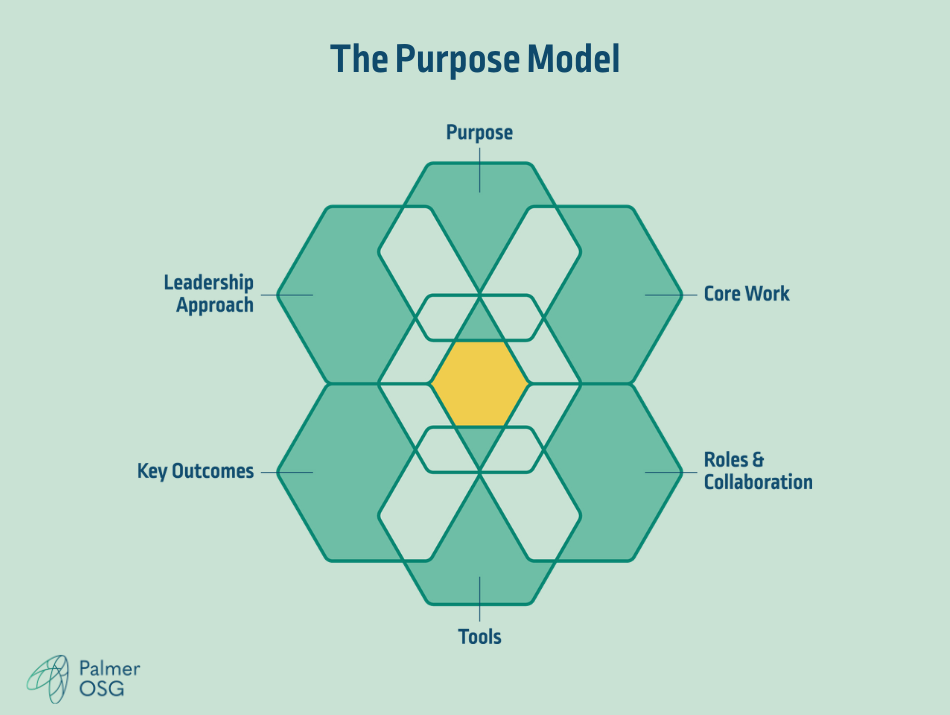Identifying & Embedding Your Purpose — Why Now?
No matter what the COVID-19 pandemic has in store for the economy, we know from lessons learned in 2008 that purpose-driven companies not only survive financial crises, they also financially outperform their non-purpose-driven peers in times of financial health. How? They have authentic commitment from their employees, customers, partners and community members.
An “ecosystem” of people who care about your business is an advantage competitors can’t replicate. So, in this downtime, connect with your organization’s purpose. Your business will realize the full benefit of its purpose when purpose drives operations. Here are 5 steps to get you started.
The 5 Steps
1 – Discover.
The first key operational element of our Purpose Model is, of course, purpose. Start here. Clarify your organization’s purpose so you can pull that thread through the rest of the business’s operational elements.
Engage a team of about 4 to 7 people with a range of seniority and tenure with the company. Together, capture the history of the company; why the business was started, the values of the founder(s), relevant historical context, etc. Discuss the relevance of those factors to today and to possible future contexts. Has the purpose evolved? Should it evolve? Have you gotten farther away from it than you’d like to be?
End this step with one clear statement about your company’s purpose — even if it’s not perfectly worded just yet.
2 – Drive.
The remaining 5 operational elements in the Purpose Model are core work, roles & collaboration methods, tools, key outcomes and leadership approach. Your business will realize the full benefit of its purpose when purpose drives these remaining elements.
Set aside two to three one-hour video conference sessions with the team established in step 1. Start answering the questions asked for each key operational element in the model — even if it’s just at a surface level for now. More than one session allows you to dive deeper into elements that may need more attention. Or, if you get through all five in one session, you can reflect, iterate and perfect in the next.
Appoint someone to capture the team’s answers to these questions and other questions they might spark for the group.
3 – Decide.
Based on your answers, decide what changes you can easily make or ideas you can easily implement (your “low-hanging fruits”). Then identify changes and ideas that are more complex, but doable with the right resources. Finally, list those changes and ideas that would be game-changers for the business, but that feel more aspirational than achievable right now.
4 – Start.
Create a plan for those low-hanging fruits. Reach out to other team members and partners to help create the plans and get them under way. Accomplishing your low-hanging fruits sparks momentum and begins to make the aspirational feel achievable.
As you’re engaging in others in this step, also share with them the longer-term and aspirational changes and ideas to be implemented. They may have ideas and resources for fleshing out action plans.
Some ideas and changes may spark more energy and momentum than others. That’s OK. Since you’ve already decided that any of them would add value to the company, then any that have energy around them will be worth pursuing.
5 – Communicate.
Share your purpose (internally and externally) and what it means for the way you do business. These communications will inspire commitment and loyalty among your stakeholders, and may even generate new ones. Communicating your purpose and how it drives your business will help you and your leadership team stay committed to and focused on your purpose.
Palmer OSG is here to help if you need it. Just reach out — we’d love to see as many businesses as possible come out of this strange time stronger than when they went into it.

